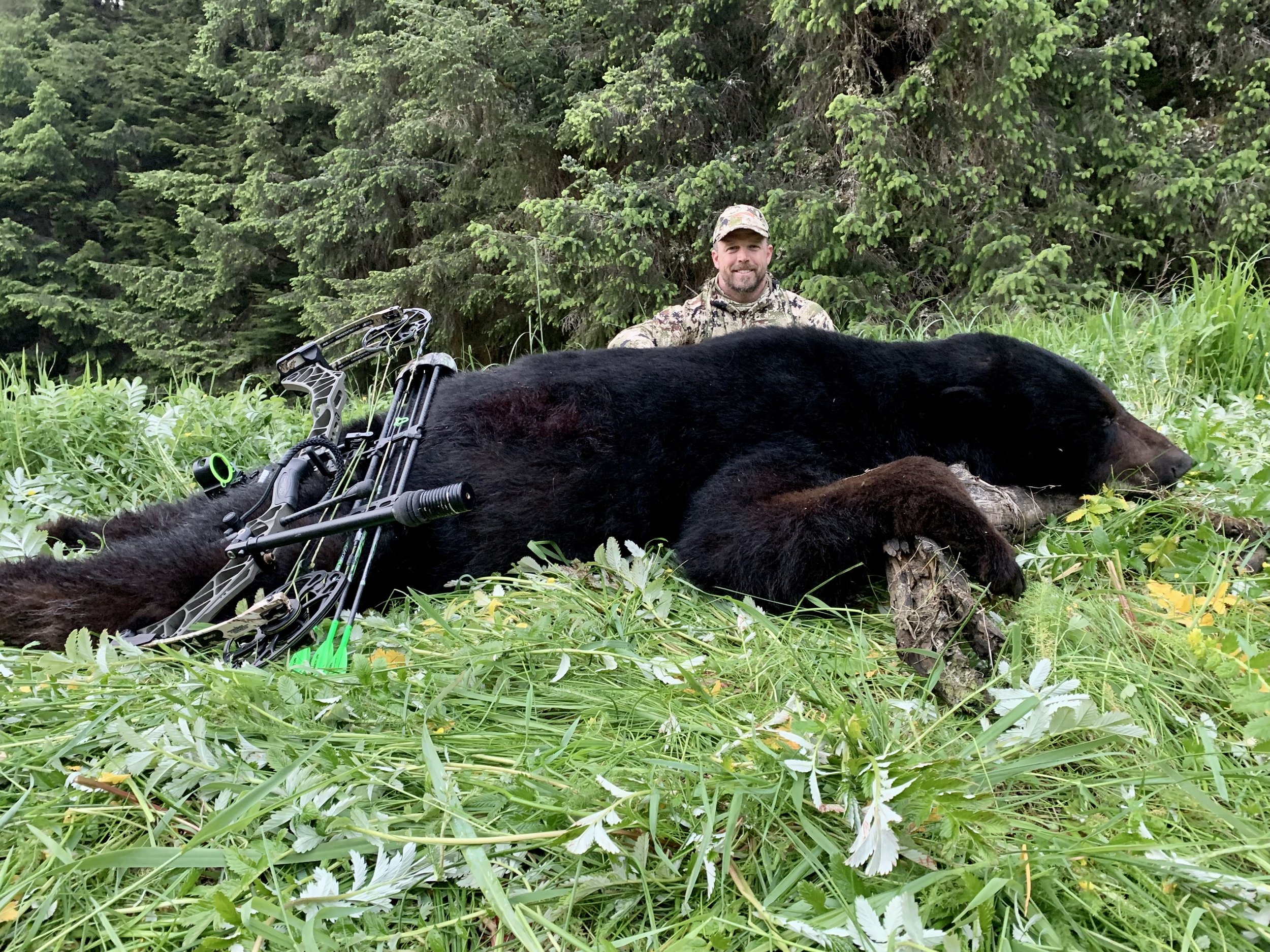Guided Black bear hunts
All of our hunts are fair chase and based from our vessel the Isla Dawn. Black bear hunts are 7 days and each hunter will be one-on-one with one of our experienced guides. Small skiffs are used to locate bears, and then put ashore for the stalk. We often hunt Kuiu Island which boasts a black bear population of four bears per square mile. Kuiu is also home to a healthy population of wolves. Black bears have a keen sense of smell, and swirling winds and changing tides can make these hunts challenging - but also rewarding as the black bear’s of Kuiu Island are some of the largest in North America. A good percentage of them make Boone and Crockett. Black bears taken with Alaska Raven Guides average 7-foot squared.
A Normal Day of Hunting
A typical day of bear hunting in Southeast Alaska starts more relaxed than many other hunts. Usually the hunt will not begin until the afternoon when things have warmed up a bit and bears are more active. Typically, a leisurely breakfast aboard the boat is followed by a few hours of glassing aboard the Isla Dawn. We’ll be looking for a suitable bear, but you’ll also see all manner of wildlife including humpback whales, orcas, Dall’s porpoise, Sitka blacktail deer, sea otters, harbor seals, bald eagles and more. The scenery in Southeast Alaska ranges from snowcapped mountains to sandy shorelines to rocky cliff outcroppings. During downtime, when not hunting, we’ll often pull up a pot of Dungeness crab for lunch or dinner.
Spring Hunts
Like brown bears, spring sees black bears emerging from their winter hibernation, showing their thick, beautiful hides as they forage for food. They look for sedge grass along the edge of the water. Sedge grass stalks are spiky, wide, and stiff, and the grass is up to 25% protein at this time of year. Consuming large quantities of fresh sedge grass helps the bears quickly replenish proteins lost during hibernation and restart their digestive system.
During the spring, hunters and guides will use skiffs to locate bears and do an initial evaluation of size and quality, and determine whether a stalk is possible based on conditions and location. Once a potential bear is located the real excitement begins! Our guide will work with the hunter to close distance and decide whether or not to harvest the bear. This can be extremely tricky as bears have an incredible sense of smell, and the slightest shift in the wind can alert the bear, who will then quickly disappear back into the protection of the dense forest.
While spring in Alaska is typically warmer than the fall, it can still be cooler out on the water, and rain is often a factor at some point during the hunt. Packing layers for changing weather conditions will allow you to regulate your temperature and keep dry; which will make a big difference in both your comfort and your success.
Fall Hunts
Come September, the fall brings streams full of spawning salmon to Southeast Alaska. During this time bears are packing in the last bit of calories before their long winter hibernation. Egg laden salmon in the tight confines of a stream are a bonanza of high fat, high calorie, protein for the bears - and also the last feast before winter sets in and the bears den up until spring. For this reason, bears are hyper-focused on feeding, and it is not unusual to see large numbers in a relatively small area feeding amongst each other.
During the fall, our hunting focus shifts to these stream-bound bears as they gorge themselves on salmon. Hunters and guides will still use skiffs to go from the boat to shore, but then they follow the stream upward to find an appropriate location to observe bears as they come and go. Guides and clients will be traversing slippery river bottoms in chest waders, in search of the right bear. The fall is also the best time for bow hunters to take a bear, as the intense feeding allows us to get in close proximity without being noticed.
Fall hunts tend to be colder and much wetter than spring hunts, so the right gear - especially quality rain gear, and chest waders and boots - is very important.
Recommended Gear & NOTES
Clothing For The Hunt
Merino base layers
Comfortable pants
Chest waders
Mid layers (i.e. sweatshirts, fleece, down coat, wool)
Windproof outer layer (Kuiu, Sitka, First Lite)
Rain gear (Grundens, Helly Hansen, Guy Cotten)
Rain boots (Xtra-Tufs)
Other items
Pajamas/lounge wear
Comfortable shoes/slippers
Personal toiletries
Medications
Favorite Snacks
NOTES
Call us for current pricing and availability for our 7 day Black Bear Hunt.
Our hunts include all accommodations, food and non-alcoholic beverages from the day your hunt begins to the day it ends. Other fees include: tag, license, city sales tax, and HPF fee. Any taxidermy fees and associated shipping fees shall be borne by the hunter.
Non-hunting guests/observers are $3,000 (1 observer per hunter permitted)
Please Note: Prices on booked hunts (signed contract) are locked in. Non-booked prices are subject to change without notice.




